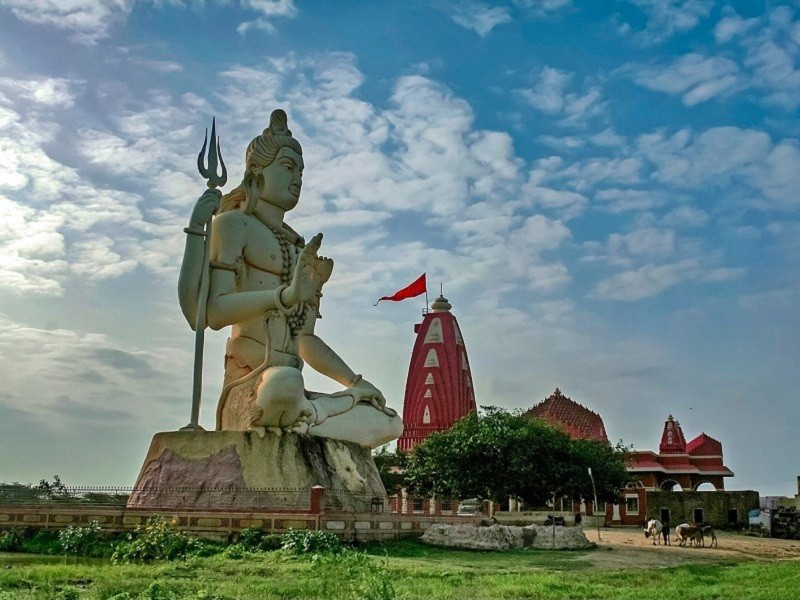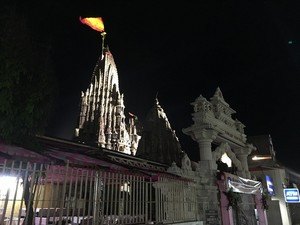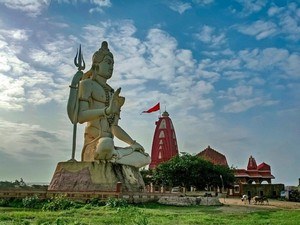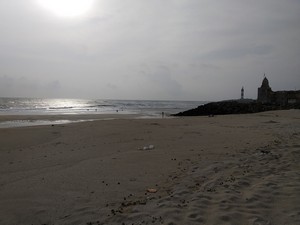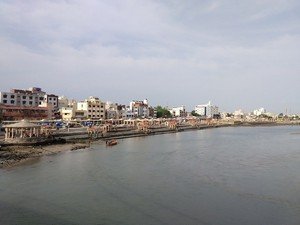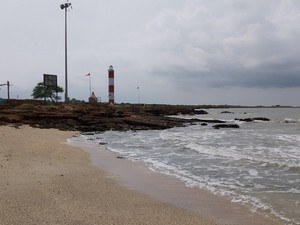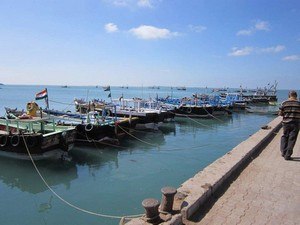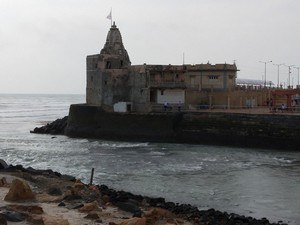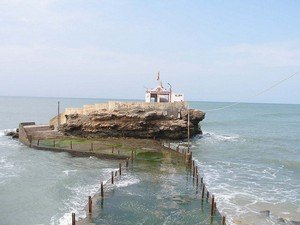Nageshwar Jyotirlinga Temple, Dwarka - Timings, Festivals, History, Darshan, Pooja Timings
Photo Credit: Flickr
 #2 of 16 Places to Visit in Dwarka
#2 of 16 Places to Visit in Dwarka
 Distance (From Dwarka): 15 Kms
Distance (From Dwarka): 15 Kms
 Trip Duration (Including Travel): 1-2 Hours
Trip Duration (Including Travel): 1-2 Hours
 Place Location: At Nageshwar Village
Place Location: At Nageshwar Village
 Transportation Options: Bus / Cab
Transportation Options: Bus / Cab
 Travel Tips: None
Travel Tips: None
About Nageshwar Jyotirlinga Temple
At a distance of 15 Km from Dwarka, Nageshwar Temple is an ancient Hindu temple located at Nageshwar village in Gujarat. Dedicated to Lord Shiva, Nageshwar Temple is one of the 12 Jyotirlinga temples of Lord Shiva, and among the oldest temples mentioned in the Shiva Purana. The Jyotirlinga has a special significance in Nageshwar as this is believed to be the 10th of all 12 Jyotirlingas. The swayambhu lingam enshrined in the underground chamber at Nageshwar Temple is known as Nageshwar Mahadev and attracts thousands of pilgrims all-round the year. This powerful Jyotirlinga symbolizes protection from all poisons and is believed that one who prays here obtains freedom from all kinds of poison including snake poison. Also known as Nagnath Temple, it is one of the popular pilgrimage sites near Ahmedabad, and among the prominent places to visit as part of Dwarka packages.
History & Mythology of Nageshwar Jyotirlinga Temple
The present Nageshwar Jyotirlinga Temple in Devbhoomi Dwarka was built in 1750 by the minister of Safdar Jung, named Naval Rai. However, according to legends, the temple's origin is connected to the Pandavas and Lord Shiva's manifestation in Darukavana. According to legend, a group of dwarf sages known as the 'Balakhilyas' devotedly worshipped Lord Shiva in Darukavana for an extended period. To test their devotion and patience, Shiva appeared to them as a naked ascetic adorned only with serpents. The sages' wives were captivated by the ascetic and pursued him, abandoning their husbands. This caused great distress and anger among the sages, leading them to curse the ascetic to lose his linga. When the linga fell to the earth, it caused the entire world to tremble. In response, Lord Brahma and Lord Vishnu approached Lord Shiva, imploring him to restore the linga and save the earth from impending destruction. Shiva reassured them and retrieved his linga, promising to remain in Darukavana as a 'jyotirlinga' for eternity. Some traditions associate the Pandavas with the discovery of the Swayambhu Shiva Linga in the middle of a river, leading to the temple's establishment.
Architecture of Nageshwar Jyotirlinga Temple
The temple is designed in the western architectural style and is oriented towards the west. The layout of the temple is based on the Sayanam posture of the human body, where the entrance symbolizes the feet, the porch adorned with idols represents the hands, the Sabha Mandap corresponds to the abdomen, and the Shiva Linga signifies the head. The temple reaches a height of 110 feet and is embellished with decorative features such as arches, columns, lotus-shaped capitals, and marble jalis. Additionally, religious symbols like the kalash and swastik are integrated into its design. Notably, this temple is distinctive as the Shiva Lingam faces south while the Gomugam is oriented eastward. The Shivalinga at Nageshwar is a Tri-Mukhi Rudraksha, measuring approximately 40 cm in height and 30 cm in diameter. Visitors to Nageshwar can also see goddess Parvati, known as Nageshwari, alongside the Shivalinga. Furthermore, a 25-meter tall statue of Lord Shiva within the temple complex captivates both tourists and pilgrims with its striking beauty.
Festivals of Nageshwar Jyotirlinga Temple
The Nageshwar Jyotirlinga Temple, located in Devbhoomi Dwarka, is famous for its annual Maha Shivratri festival, which takes place in February/March. On the eve of Maha Shivratri, a huge Mela is held on the grounds of the temple premises and thousands flock to the temple to witness the festivities. Additionally, the entire month of Shravan, spanning from July to August, is deemed particularly auspicious for Lord Shiva, with Mondays (Shravan Somvar) drawing large gatherings for prayers and ceremonies. Moreover, Kartik Purnima and Navratri are also celebrated here with great enthusiasm and grandeur.
Nageshwar Jyotirlinga Temple Dress Code & Other Restrictions
While Nageshwar Jyotirlinga Temple doesn't have a strict dress code, it is recommended to adhere to modest clothing that covers your upper arms and legs as a sign of respect. Men are encouraged to wear a dhoti or pajama paired with an upper garment, as well as formal trousers and shirts. Women may opt for a saree, half saree, or chudidhars. Men are required to remove their shirts for the Abhishek ceremony. It is advisable to refrain from wearing contemporary attire such as mini-skirts, shorts, and sleeveless tops while on the temple grounds.
Non-Hindus are welcome to explore the temple complex and appreciate its architectural beauty; however, access to the sanctum sanctorum may be restricted.
Nageshwar Jyotirlinga Temple Timings
Monday: 6 AM - 12:30 PM & 5 PM - 9:30 PM
Tuesday: 6 AM - 12:30 PM & 5 PM - 9:30 PM
Wednesday: 6 AM - 12:30 PM & 5 PM - 9:30 PM
Thursday: 6 AM - 12:30 PM & 5 PM - 9:30 PM
Friday: 6 AM - 12:30 PM & 5 PM - 9:30 PM
Saturday: 6 AM - 12:30 PM & 5 PM - 9:30 PM
Sunday: 6 AM - 12:30 PM & 5 PM - 9:30 PM
Nageshwar Jyotirlinga Temple Entry Fee
Entry is Free
Special Pooja available for Rs. 300
Best Time to Visit Nageshwar Jyotirlinga Temple
The ideal time to visit Nageshwar Jyotirlinga Temple is from October to March when the town experiences cold winters suitable for temple exploration. For those seeking to witness the temple at its most spiritually vibrant, it is recommended to schedule your visit during Maha Shivratri or the month of Shravan, when elaborate rituals and festivities enhance the temple's sacred atmosphere. Although the monsoon season from June to September transforms the surrounding landscape into a verdant paradise, the intense rainfall may pose some travel difficulties. Conversely, the summer months from April to June can be quite severe due to elevated temperatures.
How to Reach Nageshwar Jyotirlinga Temple
Jamnagar Airport is the nearest airport which is about 126 Km from Dwarka and has direct flights from Mumbai. Dwarka Railway Station is well connected by trains with Okha, Tuticorin, Guwahati, Gorakhpur, Rajkot, Ahmedabad, Somnath, Allahabad, Varanasi, Puri, Rameswaram, Jaipur, Bhavnagar, Kochi, Howrah, Nathdwara, and Viramgam. Dwarka has well road connectivity with Rajkot, Ahmedabad, Amreli, Porbandar, Somnath, Gandhidham, Bhuj, Gandhinagar, Baroda, Bhavnagar, Surat, Jamnagar, and Junagadh. About 15 Km from Dwarka, one can reach Nageshwar Jyotirlinga Temple easily by car, private taxi, or bus.



